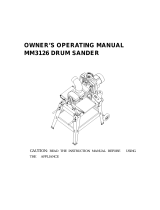
17
depend on a number of factors, including type of
stock, grit and depth of cut used, and whether the
stock is fed directly in line with the conveyor table or
at an angle. If the drum motor is lugging down, if
conveyor belt is slipping, or if you observe a ripple
effect on the stock, slow the feed rate. If the finish is
smooth and the machine is not overworking, you
can experiment using a faster feed rate.
The SandSmart controller continuously monitors the
load on the drum motor, and automatically regulates
the speed of the conveyor motor to maintain the
highest feed rate without overload.
When the red indicator light (see B, Figure 9-1)
comes on, the SandSmart control has detected too
great a depth of cut and/or too fast a feed rate.
If the load on the drum motor increases, the
SandSmart control will decrease the conveyor feed
rate and will stop the conveyor under extreme
conditions. If the load on the drum decreases,
SandSmart will increase the feed rate but will not
increase it faster than the manual setting on the
speed adjustment label.
The best and most consistent finish will be achieved
if the conveyor does not change speed during
operation.
This change in conveyor speed may affect the finish
surface. If the finish is affected, make another
sanding pass without changing any settings. If the
finish is still affected, make adjustments by slowing
the conveyor and/or decreasing the depth of cut and
run the stock through again.
Also try a faster feed rate or less depth of cut if the
stock you are working begins to show burn marks.
With cherry, hard maple or other hardwoods, using
a shallower depth of cut and a faster feed rate will
help minimize burn marks. Slightly angling the stock
as it is fed into the machine will also help prevent
burning the stock.
Because of the wide range of variables, it is
important to experiment with your specific
conditions and make adjustments to achieve the
optimum feed rate. If problems occur, first check and
adjust the feed rate, referring to the
“Troubleshooting” section in this manual.
9.6 Maximum performance tips
The versatility designed into the JWDS-series drum
sander allows it to be used for a variety of tasks that
will boost return on your investment. For example, it
will speed up fine sanding work often done with
slower, dust-generating hand sanders, and will
achieve fine thickness adjustments not possible on
some sanders. It can be used to surface figured
woods – bird’s eye or curly maple, for example –
which can be damaged if fed through a planer.
Learning how to use its adjustments and controls
will allow you to fine-tune the machine for maximum
results. The best results come from experimenting
with different abrasive grits and machine
adjustments to fit the job at hand. Following is a list
of useful tips which can help you improve
performance of your sander.
9.6.1 Dust collection
When connecting dust collectors, remember that
straight pipe will not restrict airflow as much as
flexible tubing. Y’s and elbows will restrict airflow
less than T’s. Also, a hose smaller than 2-1/2”
diameter should not be used.
9.6.2 Multiple-piece sanding runs
When abrasive planing (or thickness sanding) a run
of similar pieces that you want to have the same
thickness, it is best to determine the thickness of the
thinnest piece and process all pieces to that same
thickness in one session. Be aware that the sander
will remove cups and crowns in the workpiece;
consider this when measuring and processing stock
to the same thickness.
9.6.3 Simultaneous multiple pieces
When sanding multiple pieces simultaneously,
make sure to stagger (step) the pieces across the
width of the conveyor belt. This provides better
contact with the tension rollers. Try to process only
multiple pieces of similar thickness.
If there is a significant thickness difference, the
thinner pieces can slip on the conveyor belt if they
do not contact the tension rollers. Also note that
pieces thicker than 3/4” should be longer than the
minimum normally recommended to prevent tipping
of the stock.
9.6.4 Edge sanding
When edge sanding, the sander will mimic the
opposite edge of the stock which is lying on the
conveyor belt. Because of this, it is important for the
stock edge to have been ripped at the proper angle
to the face before the sanding process. When edge
sanding stock that is less than 3/4” wide or more
than 2” high, it is good procedure to stack and clamp
several pieces together to prevent them from
slipping or tipping on the conveyor belt.
9.6.5 Sanding imperfect stock
When sanding stock with a cup or crown, place the
crown up. This will stabilize the stock to help prevent
tipping or rocking during sanding. After the crown
has been removed and the top is flat, turn the stock
over and sand the opposite side. To avoid personal
injury, take special care when sanding stock that is
twisted, bowed, or otherwise varies in thickness
from end to end. If possible, support such stock as
it is being sanded to keep it from slipping or tipping.
Use extra roller stands, help from another person,
or hand pressure on the stock, to minimize
potentially hazardous situations.






















